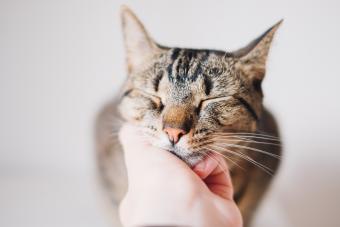
All cat bites to humans, from little nips to deep punctures, can result in swelling, pain, and other concerning symptoms. A bite from a cat should not be taken lightly, as many become infected. Learn how to spot the signs of a cat bite infection so you know when it's time to get medical help.
Why Are Cat Bites So Dangerous?
Although both dog and cat saliva contain many types of bacteria, a person is more likely to get an infection from a cat bite than a dog bite. The most common cause of cat bite infections is the bacteria Pasteurella multocida, which over 90 percent of cats carry. Cats' teeth are also sharper and longer than their canine counterparts, so the bacteria can easily become trapped under the skin. Cat bites produce small, deep puncture wounds that are difficult to clean.
Most experts agree that all cat bites should be seen by a doctor as soon as possible due to the high risk of infection. Data suggests that up to 80 percent of cat bites become infected. While mild infections cause slight discomfort, serious ones can be life-threatening.
Symptoms of Infected Cat Bites

A cat bite infection can develop as soon as 24 to 48 hours of being bitten. However, infections caused by Pastuerella bacteria may show signs within three to six hours. The following common signs of infection should not be ignored.
1. Redness
One of the first signs your bite may be getting infected is redness around the wound. This can vary from light pink to a dark, angry-looking crimson red. If the area is getting red, watch for any spreading of redness outward to the rest of the body. Spreading of redness could indicate blood poisoning.
2. Heat
Whether or not the bite begins to redden, check it often to make sure it is not warmer than the other parts of your body. As your body sends white blood cells to fight infection, the temperature around the infected area may heat up even before the area turns red.
3. Odor
Some bites develop an unusual odor. It may be difficult to detect at first, but the wound may smell if untreated.
4. Pus or Oozing
When bacteria from a cat's tooth is trapped within the wound, infected liquid known as pus can accumulate. This collection of discharge is called an abscess and may puff up or ooze from the bite.
5. Fever
As your body works to fight the bacteria in the cat bite, you may develop a fever. A fever is considered a temperature of 100.4 degrees Fahrenheit or higher.
6. Discomfort
Any time the skin is punctured, you will experience some level of discomfort, but this initial pain should subside. However, when a bite is infected, the pain often worsens and spreads to the tissues surrounding the wound.
7. Swelling
Slight swelling following trauma to the skin and deeper tissues is not unusual, but most swelling goes away within a few days. A cat bite that stays swollen or increases in size is likely infected.
Diseases From Cat Bites
Infection isn't the only concern when dealing with a cat bite. There are a few bacterial and viral diseases cats can pass on to humans through transmission of bodily fluids. Monitor for these symptoms as well and ask your physician about the following diseases if you're worried about exposure from a cat of unknown history or vaccination status, such as a stray cat.
Cat-Scratch Fever

Transmitted by a scratch or bite, cat-scratch disease, more commonly referred to as cat-scratch fever, is caused by the bacteria Bartonella henselae. Approximately 40 percent of cats carry this bacteria and most do not have any signs. Cat scratch disease is generally not serious in people with healthy immune systems, but if you suffer from a compromised immune system due to an existing medical condition, you must seek medical attention if a cat bites you. Symptoms include:
- A blister or small bump (swelling) forming at the site of the bite
- Tenderness and swelling of the lymph nodes
- Fever
- Chills
- Headache
- Fatigue
- Sore throat
- Rash
- Nausea
- Vomiting
- Loss of appetite
Cat-scratch fever symptoms typically occur three to 30 days after the bite, with most cases developing in the first one to two weeks. Your doctor will most likely prescribe antibiotics. The illness usually lasts two to four months, but may last up to a year.
Tetanus
Tetanus is caused by bacteria called Clostridium tetani, which cats and other animals can carry. If you haven't had a tetanus booster within the last 5 years, it's important to see your doctor. Most people develop symptoms within 3 to 21 days of exposure, and if left untreated, tetanus can be life-threatening. Signs of tetanus include:
- Stiffness in jaw, neck, and mouth
- Trouble swallowing
- Muscle spasms
- Headache
- Fever
Rabies
Humans can contract the rabies virus from infected cats through saliva after sustaining a bite. Fortunately, the incidence of rabies in cats is very rare because rabies vaccination is required by law for all domestic pets. However, you should still be cautious about this life-threatening condition and proceed based on your relation to the cat who bit you.
- The CDC reports that if the cat is healthy, it should be quarantined by their owner and monitored for signs of rabies for 10 days, regardless of their vaccination status.
- If the cat who bit you appears ill or becomes ill within the 10 day confinement period, it should be examined by a veterinarian and you should speak to your physician about possible vaccination.
- If the biting cat was a stray or an unknown cat and you're not sure if they were healthy, ill, or possibly rabid, it's important to see your doctor immediately to begin treatment with a rabies vaccination.
Treating a Cat Bite
You can lower the chance of infection from a cat bite by taking these steps right away:
- Wash your hands or put on rubber gloves before beginning treatment.
- If the bite is bleeding, apply direct pressure to the wound with a clean, dry cloth. Continue applying pressure until the bleeding stops. If the bleeding does not stop with pressure, seek urgent care.
- When the bite is no longer bleeding or only bleeding slightly, wash the area for several minutes with antibacterial soap and water. Use running water with high pressure if possible.
- Rinse the wound thoroughly for at least 5 minutes, but avoid scrubbing it.
- Sterilize the area with dilute Betadine or Chlorhexidine solution or soak it in a solution of Epsom salts and warm water.
- You can apply an antibiotic ointment or cream.
- Cover the bite with a sterile dressing.
- Contact your doctor and watch the bite area for signs of infection.
Take Every Cat Bite Seriously
Never make the mistake of ignoring a bite wound. Clean it properly and call your family doctor about having the bite examined. If you notice any signs of infection, seek urgent care, as infected cat bites can escalate quickly.







